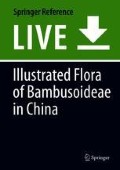Abstract
Shrubby bamboos. Rhizomes monopodium or amphipodium. Culms diffuse, erect; internodes terete or a little flat at the bottom of the branching side; culm nodes prominent. Branches 3 on each node or 3–5 branches on the upper nodes. Culm sheaths deciduous, thickly papery, shorter than internodes; auricles developed, oral setae flexuous; ligules a little arched; blades spreading, deciduous. Several leaves per branchlet; auricles tiny, oral setae present; ligules short; leaf blades lanceolate to oblong lanceolate, transverse veins conspicuous. Internodes of flowering branches extremely shortened, short spiciform or capitate, singular on nodes of branchlets with leaves, pseudospikelets 2–8, subtended by 1 prophyll and several bracts gradually larger upward, the upper bracts spathe-shaped; spathe-shaped bracts 2–4, 1–3 pseudospikelets within each bract; florets 5–7; glumes 1–3, when glumes 3, the first one scale-like, vein 1, the others lemma-like, but a little shorter; lemma with several veins, apex acute, transverse veins inconspicuous; palea 2- keeled, apex bifid; lodicules 3, seldom 4, nearly equal in size, the back one narrower, lanceolate, the front 2 (3) obovate or spathulate, the base with veins, densely tomense abaxially, margins ciliate; stamens 3, filaments free; style 1, long, stigmas 3, slender, plumose. Caryopses. New shoots May to June. Flowering March to May.
References
Bamboo Phylogeny Group (BPG) (2012) An updated tribal and subtribal classification of the bamboos (Poaceae: Bambusoideae). In: Gielis J, Potters G (eds) Proceedings of the 9th world bamboo congress, 10–15 April 2012. Antwerp. World Bamboo Organization, Belgium, pp 3–27
Keng PC, Wang ZP (1996) Bambusoideae. Flora Reipublicae Popularis Sinicae, vol 9(1). Science Press, Beijing. (in Chinese)
Li DZ, Wang ZP, Zhu ZD, Xia NH, Jia LZ, Guo ZH, Yang GY, Stapleton CMA (2006) Bambuseae (Poaceae). In: Wu ZY, Raven PH, Hong DY (eds) Flora of China. Science Press/Missouri Botanical Garden Press, Beijing/St. Louis
Shi JY, Yi TP, Ma LS, Wang HT, Yang L (2012) The ornamental bamboos in China. Science Press, Beijing
Triplett JK, Clark LG (2010) Phylogeny of the temperate bamboos (Poaceae: Bambusoideae: Bambuseae) with an emphasis on Arundinaria and allies. Syst Bot 35(1):102–120
Yi TP, Shi JY, Ma LS, Wang HT, Yang L (2008) Iconographia Bambusoidearum Sinicarum. Science Press, Beijing
Yi TP, Shi JY, Ma LS, Zhang YX, Zhou DQ, Yao J (2017) Iconographia Bambusoidearum Sinicarum II. Science Press, Beijing
Author information
Authors and Affiliations
Corresponding author
Rights and permissions
Copyright information
© 2020 Science Press and Springer Nature Singapore Pte Ltd.
About this entry
Cite this entry
Shi, J.Y., Zhang, Y.X., Zhou, D.Q., Ma, L.S., Yao, J., Zhang, L.N. (2020). Brachystachyum Keng. In: Illustrated Flora of Bambusoideae in China. Springer, Singapore. https://doi.org/10.1007/978-981-10-8580-2_14-1
Download citation
DOI: https://doi.org/10.1007/978-981-10-8580-2_14-1
Received:
Accepted:
Published:
Publisher Name: Springer, Singapore
Print ISBN: 978-981-10-8580-2
Online ISBN: 978-981-10-8580-2
eBook Packages: Springer Reference Biomedicine and Life SciencesReference Module Biomedical and Life Sciences

